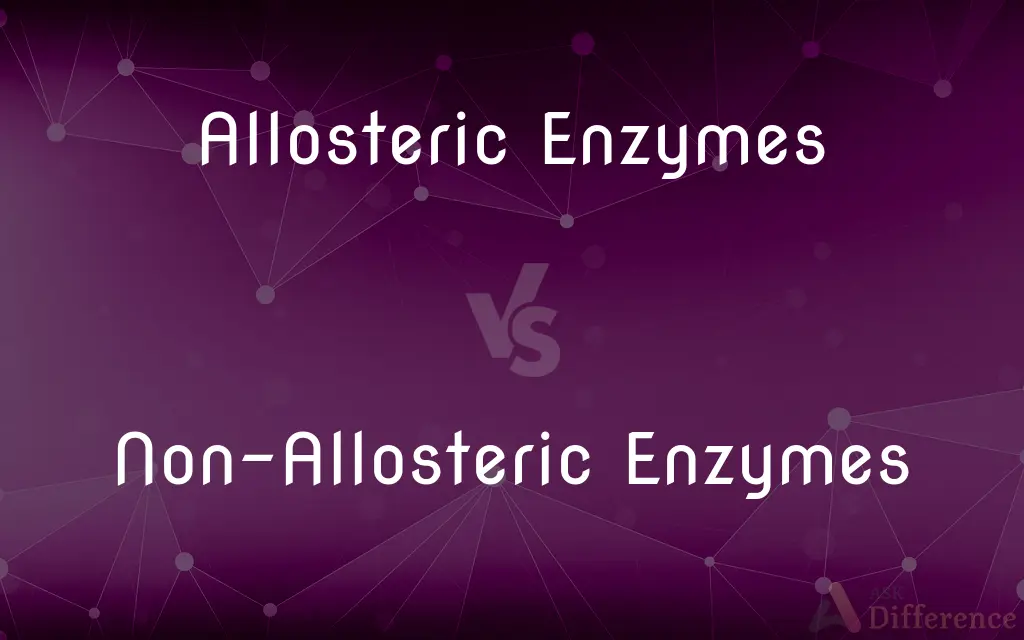Allosteric Enzymes vs. Non-Allosteric Enzymes — What's the Difference?
By Tayyaba Rehman & Urooj Arif — Published on February 17, 2024
Allosteric enzymes regulate activity via binding at sites other than the active site; non-allosteric enzymes lack this regulation, operating more directly.

Difference Between Allosteric Enzymes and Non-Allosteric Enzymes
Table of Contents
ADVERTISEMENT
Key Differences
Allosteric enzymes are proteins that can regulate their activity through the binding of effector molecules at sites other than the enzyme's active site, known as allosteric sites. This binding causes a conformational change in the enzyme, altering its activity. This regulation allows allosteric enzymes to play crucial roles in metabolic pathways, acting as on/off switches for pathway regulation. Allosteric enzymes can be activated or inhibited by their effectors, making them key points of control in cellular processes.
Non-allosteric enzymes, in contrast, do not have this secondary binding site and thus do not undergo the same regulation via conformational changes induced by effector molecules. Their activity is directly related to substrate concentration, following Michaelis-Menten kinetics, where reaction rate increases with substrate concentration until a maximum velocity (Vmax) is reached. Non-allosteric enzymes typically operate in a more predictable and straightforward manner compared to their allosteric counterparts.
The main difference between the two lies in their mechanism of action and regulation. Allosteric enzymes offer a sophisticated means of controlling biochemical pathways with high sensitivity to the cellular environment's fluctuations. This allows cells to finely tune enzyme activity in response to various signals. Meanwhile, non-allosteric enzymes provide a consistent, regulated pace for reactions that do not require rapid or frequent adjustments.
Allosteric regulation is essential for maintaining homeostasis within cells, allowing for the integration of metabolic signals and the coordination of metabolic pathways. Non-allosteric enzymes, while less flexible in regulation, ensure the steady progress of essential biochemical reactions necessary for cell survival and function.
In essence, while both allosteric and non-allosteric enzymes catalyze biochemical reactions, their capacity for regulation and response to cellular conditions vastly differs. Allosteric enzymes are key to dynamic metabolic regulation, while non-allosteric enzymes sustain basic cellular processes through consistent activity.
ADVERTISEMENT
Comparison Chart
Regulation
Regulated by effectors at non-active sites
Activity mainly influenced by substrate concentration
Mechanism of Action
Undergo conformational changes
Do not undergo conformational changes due to effector binding
Role in Metabolic Pathways
Act as metabolic regulators
Participate in steady-state processes
Sensitivity to Cellular Conditions
Highly sensitive, allowing for rapid response
Less sensitive, providing consistent activity
Kinetics
Do not follow Michaelis-Menten kinetics
Follow Michaelis-Menten kinetics
Compare with Definitions
Allosteric Enzymes
Exhibit cooperative binding effects.
Hemoglobin is an example of an allosteric enzyme with cooperative oxygen binding.
Non-Allosteric Enzymes
Lack secondary regulatory sites for effector molecules.
Without allosteric sites, non-allosteric enzymes cannot be turned off by inhibitors as easily.
Allosteric Enzymes
Sensitive to environmental fluctuations.
Allosteric enzymes adjust their activity in response to cellular energy levels.
Non-Allosteric Enzymes
Operate based on Michaelis-Menten kinetics.
The reaction rate of non-allosteric enzymes plateaus at a maximum velocity.
Allosteric Enzymes
Integral to cellular feedback mechanisms.
Allosteric enzymes are crucial for turning metabolic pathways on and off.
Non-Allosteric Enzymes
Provide consistent activity for cellular processes.
Non-allosteric enzymes ensure the steady progress of essential biochemical reactions.
Allosteric Enzymes
Undergo conformational changes affecting their activity.
The binding of an effector transforms the allosteric enzyme's shape and function.
Non-Allosteric Enzymes
Enzymes whose activity is directly related to substrate concentration.
Non-allosteric enzymes follow a predictable pattern of activity increase with more substrate.
Allosteric Enzymes
Enzymes regulated by molecules binding at non-active sites.
Allosteric enzymes can dramatically change activity with small molecular signals.
Non-Allosteric Enzymes
Less involved in rapid metabolic regulation.
These enzymes maintain basic functions without fluctuating activity levels.
Common Curiosities
What defines an allosteric enzyme?
Enzymes regulated through binding at sites other than their active site.
Can allosteric enzymes be inhibited?
Yes, by molecules binding to their allosteric sites.
What is a common example of an allosteric enzyme?
Hemoglobin, for its regulation of oxygen binding.
Do all enzymes have allosteric sites?
No, only allosteric enzymes possess these regulatory sites.
How do effectors influence allosteric enzymes?
By causing conformational changes that alter enzyme activity.
Why are non-allosteric enzymes important?
They provide consistent, regulated activity for steady-state processes.
How does substrate concentration affect non-allosteric enzymes?
Increases in substrate concentration lead to increased activity until Vmax is reached.
How do non-allosteric enzymes function?
Their activity is based directly on substrate concentration.
Can allosteric enzymes follow Michaelis-Menten kinetics?
Typically, no, due to their cooperative binding behavior.
What role do allosteric enzymes play in metabolism?
They act as regulators, adjusting pathway activities in response to cellular needs.
Are allosteric enzymes specific to certain substrates?
Yes, their active sites are specific, but their regulation can involve different molecules.
Can the activity of non-allosteric enzymes be modified?
Only through changes in substrate concentration or through genetic modification.
What is a key advantage of allosteric regulation?
It allows for rapid and efficient response to changes in cellular conditions.
How is enzyme specificity different between the two types?
Specificity is not inherently different, but regulation mechanisms vary.
How do cells use allosteric enzymes for feedback control?
By utilizing end products of pathways to inhibit upstream enzymes, thus regulating the pathway's activity.
Share Your Discovery

Previous Comparison
Anodic Protection vs. Cathodic Protection
Next Comparison
De Broglie vs. Heisenberg Uncertainty PrincipleAuthor Spotlight
Written by
Tayyaba RehmanTayyaba Rehman is a distinguished writer, currently serving as a primary contributor to askdifference.com. As a researcher in semantics and etymology, Tayyaba's passion for the complexity of languages and their distinctions has found a perfect home on the platform. Tayyaba delves into the intricacies of language, distinguishing between commonly confused words and phrases, thereby providing clarity for readers worldwide.
Co-written by
Urooj ArifUrooj is a skilled content writer at Ask Difference, known for her exceptional ability to simplify complex topics into engaging and informative content. With a passion for research and a flair for clear, concise writing, she consistently delivers articles that resonate with our diverse audience.












































